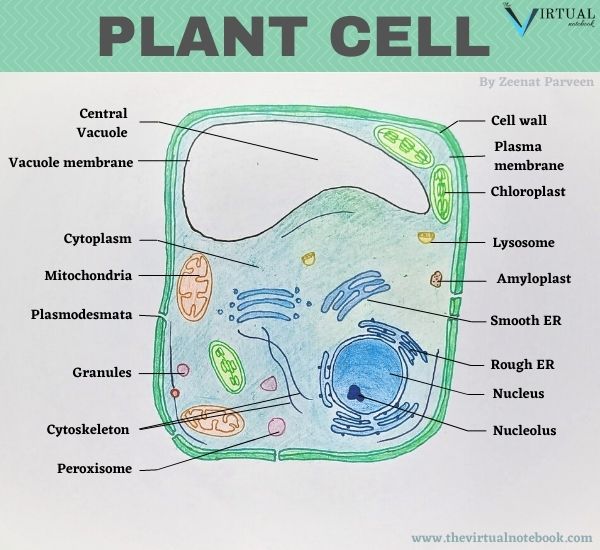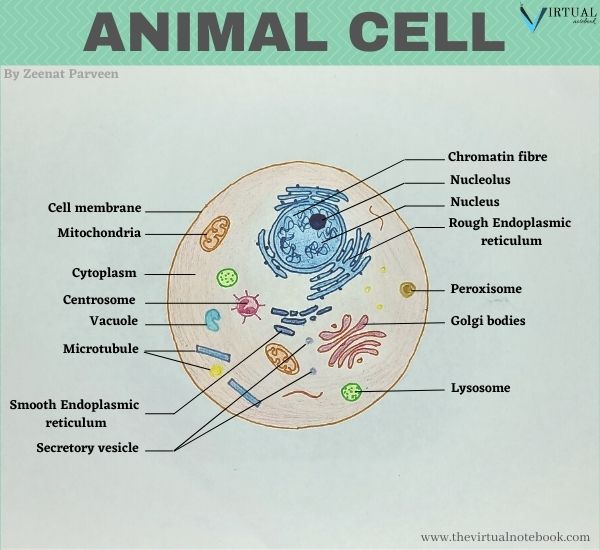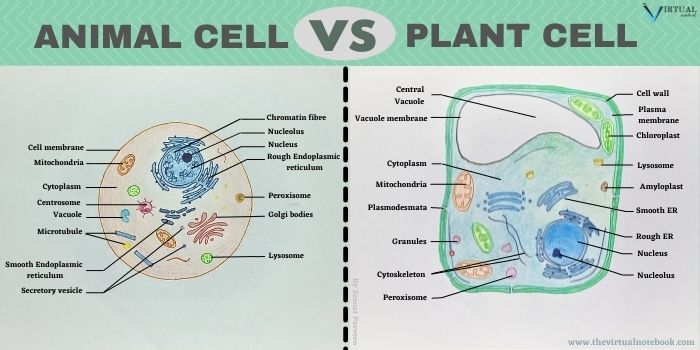A Cell is the smallest structural and functional unit of life. Typically, there are two types of cells, i.e., prokaryotic and eukaryotic cells. Prokaryotes are pre-existing cells and eukaryotes evolved later. Both plants and animals cells are eukaryotes. Both share so many structural and functional similarities yet contrasting characteristics.
A plant cell structure is very similar to that of the animal cell, the two types of cells contain many of the same organelles. These organelles carry out the same functions in both types of cells. Aside from common organelles, plant and animal cells are very different. Plant cells are very unique because of the presence of three additional structures. These structures (a cell wall, vacuoles, and plastids) are important to a plant’s ability to function.
What is a Plant Cell?
Plant cells vary considerably in size, shape and structure. It is, therefore, difficult to present a general picture of plant cells. Typically, plant cells are cubic or rectangular in shape and a lot bigger than animal cells in structure. They are very unique because of the presence of three additional structures. These structures (cell wall, vacuoles, and plastids) are important to a plant’s ability to function.

The cytoplasm of plant cells is an aqueous medium of different viscosity and composition which contains membrane-bound bodies known as organelles. Also embedded in the cytosol are chloroplasts (plastid), mitochondria, ribosomes, Golgi apparatus, peroxisomes, glyoxysomes, spherosomes, microtubules and microfilaments (part of the cytoskeleton).
What is an Animal cell?

Like plant cells, they are also eukaryotic cells but lack an outer cell wall. They have a true membrane-bound nucleus along with other cellular content. Animal cells are generally smaller in size as compared to plant cells and may contain more than one vacuole.
Similarities between plant cell and animal cell
- Ribosomes: bothe cells have ribosomes.
- Endoplasmic Reticulum: it is present in both plant and animal cells.
- Mode of reproduction: both have similar reproduction process of Mitosis and Meiosis.
- Both have cell membrane or plasma membrane
- plant cell and animal cell have well defined nucleus, cytoplasm, mitochondria, peroxisomes, vacuoles and DNA as their genetic material.
- Cytoskeleton System: both cells have well-develped cytoskeleton system.
Difference between Plant cell and Animal cell
Morphologically, animal cells are smaller than plant cells. They both have differences in their shape and sizes. Lets discuss various differences in detail.
What is plant/animal cells?
Plant cell: Plant cells have a membrane-bound nucleus and vary greatly in size, form, structure, and function. Some are measured in micrometres, others in millimetres, and still others in centimetres (fibres in certain plants).
Animal cell: An animal fall under the category of eukaryotic cell that lacks a cell wall and has a true, membrane-bound nucleus along with other cellular organelles.
Plant cell vs animal cell organelles
Although the plant cell structure is very similar to that of the animal cell, the two types of cells contain many of the same organelles. These organelles carry out the same functions in both types of cells. Aside from common organelles, plant and animal cells are very different.
Plant cells are very unique because of the presence of three additional structures. These structures (a cell wall, vacuoles, and plastids) are important to a plant’s ability to function.
A plant/animal cell has various cell organelles:
- Cell wall: It is the outermost boundary of the eukaryotic plant cell. Due to the presence of cell wall, the structure of plant cell is more rigid than animal cell. However, it is absent in animal cells.
- Cytoplasm: It is thick semi-fluid substance of the cell lying just below the cell membrane. It is present in both plant and animal cells.
- Plasma Membrane: It separates the interior of the cell from the ouside environment and present between the cell wall and the cytoplasm. It is present in both types of cell.
- Nucleus: It contains the blueprint that determine the structure and function of both plant cell and animal cell. It is present in both types of cells. Although, it is the largest organelle present in animal cell while not a case plant cell.
- Ribosomes: They are protein builders/synthesizers of the cell. They are present in both cells.
- Cytoskeleton: it is a network of interconnected protein filaments and tubules that extends from the plasma membrane to the nucleus in both animal and plant cells. In animal cells, Microtubules (of cytoskeleton) usually radiate from the centrosome located near the nucleus. On the other hand, they are more near the plasma membrane in plant cells.
- Golgi complex: It is an organelle that sorts and modifies proteins and lipids (fats). They are present in both the cells. These small connected units are called dictysomes in plant cells instead of golgi bodies.
- Endoplasmic Reticulum: it is an organelle that contain a series of flattened sacs within the cytoplasm. Its main function is to modify and synthesis proteins in eukaryotic cells. Again, it is present in both plant cell and anima cell.
- Plastids: These are double membrane-bound organelles that show great variations in shape, size and numbers. They are only present in plant cell while absent in animal cells.
- Mitochondria: They are also double membrane structures and are oftern called the power house of the cell. Plant cell contain fewer mitochondria than animal cells.
- Vacuoles: Together with the presence of plastids and cell wall, the vacuole is one of the three characteristics that distinguish plant cell from an animal cell. Vacuoles are present in both the cell but vacuole in plant cell is larger than vacuoles in animal cell. Vacuole is also permanent in plant cell whereas it is temporary in animalc cell.
Size
Plant cells are much larger than animal cells. The normal range for an animal cell varies from 10-30 μm while that for a plant cell stretches from 10-100 μm.
Shape
Plant cells show a wide range of shapes and internal structures, depending on their function. Typically, plant cells are cubic or rectangular in shape and a lot bigger than animal cells in structure. On the other hand, animal cells are irregular due to the absence of a cell wall.
Cilia and flagella
Cilia: they are small, slender, hair-like structures present on the surface of eukaryotic cells. They are of two types: Motile and non-motile.
Flagella: It is also a lash-like structure that protrudes from the cell body.
Cilia and flagella help in the locomotion and sensing of the extracellular environments. They are present in animal cells whereas absent in plant cells.
Plasmodesmata
These are pores or channels present in the cell wall of plant cells. They link adjacent plasma membranes and cytoplasm. Also, they help in the communication and transport of materials across plant cells. As they are only present in the cell wall, they are unique to plant cells. Hence, absent in animal cells.
Plant cell VS animal cell diagram

Plant cell VS animal cell table
| CHARACTERISTICS | ANIMAL CELL | PLANT CELL |
|---|---|---|
| Definition | These are eukaryotic cell that have plasma membrane as their outermost organelle. | They are also eukaryotic cell that have cell wall as their outermost membrane along with other different organelles. |
| Kingdom | Animalia | Plantae |
| Size | smaller. Size of cell varies from 10-30 μm. | Larger than animal cells. cell varies from 10-100 μm. |
| Shape | They are round to irregular in shapes | They vary greatly in size, form, structure, and function. Plant cells are cubic or rectangular in structure. |
| Cell wall | it is absent. | Cellulose cell wall is present. |
| Effect of hypotonic solution | Animal cells can easily bursts when placed in hypotonic solution because of the lack of a cell wall | They do not burst in a hypotonic solution due to the presence of a cell wall. |
| Largest organelle | Nucleus | Plastids |
| Golgi bodies | Well developed Golgi bodies are are that have two cisternae. | It is present in the form of units known as dictyosomes |
| Centriole | Present | Absent in higher plants but some lower plants do have centrioles. Example: Algae, chlamydomonas |
| Mode of nutrition | Heterotrophic | Autotrophic |
| Ability to make own food | As they are heterotrophic, they cannot produce their own food. | They can synthesize their own food. |
| Chloroplast | Absent | Present. It enables plants to perform photosynthesis. |
| Vacuole | Present but smaller than plant cell. | It is also present but much larger than animal cell. |
| Nature of vacuole | Numerous and temporary | One, permanent and central vacuole is present in mature plant cell. |
| Cell Membrane | It is the outermost membrane in animal cell that encloses the cellular contents. | It is present beneath the cell wall in plant cells. |
| Cytoplasm | It houses all the cell organelles. | It houses most of the cell organelles. |
| Centrosomes | Present | Absent |
| Plastids | Absent | Present They provide color to the plants and helps in trapping the light energy. |
| Cilia | It is present in certain cells. Example: epithelium lining of respiratory tract. | Absent |
| Flagella | Certain animal cells have flagella. Example: spermatozoa | It is absent. |
| Mitochondria | They are present in abundant | They are also present in plant cell but their number is much lower than animal cells. |
| Plamodesmata | Entirely absent in animal cells. | Present in the cell wall of plant cell. |
| Microtubules | Microtubules (of cytoskeleton) usually radiate from the centrosome located near the nucleus. | they are more near the plasma membrane in plant cells. |
| Nucleus | Present. It is the largest organelle in animal cells | Present. It is not the largest organelle in plant cell. |
| Lysosomes | Present | Rarely present as the plant vacuole and the Golgi bodies handle molecule degradation of waste cellular products. |
| Endoplasmic reticulum | it is present | present |
| Microvilli | Present. Example: intestinal lining of digestive system | It is absent |
| Endosomes | These are membrane-bound vesicles present in the cytoplasm of all the animal cells. | Present. Plant endosomes have different structural and functional organizations as compared to animal cells. |
References
Cell biology: organelle structure and function by David E. Sadava. Page no.241-263, page no. 295-303, chapter 9
Cell biology by David E. Sadava; CBS publisher; from page no. 213-225
Cell and molecular biology by Prakash S. Lohar; MJP Publishers; from page no. 16-18, 96-98, 115-117, 122-130
The cell: A molecular approach by Geoffrey M. cooper, fourth edition
Cell biology, genetics, molecular biology, evolution and ecology by P.S Verma and V.K. Aggarwal; page no. 146-148, 186-190
Essau’s Plant Anatomy, third edition, chapter: The Protoplast: Plasma Membrane, Nucleus, and Cytoplasmic Organelles
Plant Biochemistry edited by P.M. Dey and J.B. Harborne, chapter no. 1: The plant, the cell and its molecular component
Essentials of biology, fifth edition by Sylvia S. Mader and Michael Windelspecht
Lehninger; principles of biochemistry by Michael M. Cox and David E. nelson, page no. 246,247, 795-96.
https://byjus.com/biology/animal-cell/
https://byjus.com/biology/difference-between-plant-cell-and-animal-cell/
https://biologydictionary.net/animal-cell/
https://www.thoughtco.com/all-about-animal-cells-373379
Plant Cell vs. Animal Cell (25 Major Differences)